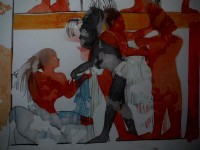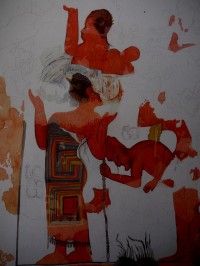 A team of archaeologists from the University of Valencia, Spain, and the University of San Carlos of Guatemala have discovered the first known Mayan fresco, a mural painted on wet plaster, near the archaeological site of La Blanca in northern Guatemala close to the border with Belize. All the other extant wall paintings done by the Maya were created using a dry paint technique. These frescoes date to the eighth century A.D., the Late Classic period, when they were painted on the walls of room six in Chilonche Palace. The room was sealed in antiquity, leaving the murals in exceptional condition while those in other rooms of the palace have faded to near nothingness.
A team of archaeologists from the University of Valencia, Spain, and the University of San Carlos of Guatemala have discovered the first known Mayan fresco, a mural painted on wet plaster, near the archaeological site of La Blanca in northern Guatemala close to the border with Belize. All the other extant wall paintings done by the Maya were created using a dry paint technique. These frescoes date to the eighth century A.D., the Late Classic period, when they were painted on the walls of room six in Chilonche Palace. The room was sealed in antiquity, leaving the murals in exceptional condition while those in other rooms of the palace have faded to near nothingness.
“It’s an extraordinary discovery because of the information it provides, both historically and because of the pictorial technique and from an artistic point of view they are exceptional. There are three aspects [to this find]: the history, the pictorial technique and the artistic excellence; the great plasticity of the figures, the colors and also for the good state of conservation, very good for a site in tropical conditions, said Cristina Vidal, [scientific director of the archaeological project].
The Maya used natural pigments to create the brilliant colors of their murals. The most famous is Maya blue, still being studied today by scientists keen to understand how its components, mainly indigo and a white clay mineral called palygorskite, came together to create such a rich and durable pigment. The newly discovered frescoes include some Maya blue elements. The dominant color is a red made by mixing ground up iron oxide with water. The white background was made with white lime, the blacks and greys with charcoal and the yellow with the mineral goethite.
 There are adult men, women and children depicted in the murals, many of them labelled with their names. Identifying each figure’s name, date and any historical data is a top priority for the team. The paintings show people of all different types and classes bringing an offering to an illustrious personage of some kind. Archaeologists believe this is a historical event being depicted, not a mythological scene.
There are adult men, women and children depicted in the murals, many of them labelled with their names. Identifying each figure’s name, date and any historical data is a top priority for the team. The paintings show people of all different types and classes bringing an offering to an illustrious personage of some kind. Archaeologists believe this is a historical event being depicted, not a mythological scene.
The Palace of Chilonche, while just 10 miles southwest of the archaeological zone of La Blanca, is on privately held land. This makes it basically impossible to police. The site has been looted on a regular basis and it makes protecting and conserving the finds a challenge. It will therefore not be opened to tourists any time soon.
Now off I go to check every Mayan mural post I ever wrote for sloppy use of the word “fresco.” I know it means wet painting, but in my eternal search for a varied vocabulary, I’m sure I used it to describe what I now know were exclusively dry painted works. :facepalm: